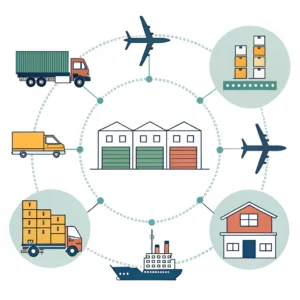Reducing customs clearance delays in global supply chains starts with ensuring complete and accurate documentation, leveraging technology for compliance, and engaging experienced customs brokers to navigate changing international regulations.
Customs clearance delays affect global supply chains in several critical ways, from increasing shipping costs to disrupting customer expectations. Customs clearance optimization1 is a key priority for logistics managers and procurement professionals. Delays usually stem from documentation errors, non-compliance with local and international regulations, and inefficient internal processes. In an industry where every hour counts, addressing these delays is crucial for maintaining supply chain efficiency and achieving smooth international operations.
-
Incorrect or Incomplete Documentation:
Errors in crucial documents—such as commercial invoices, packing lists, bills of lading, and certificates of origin—are a leading factor behind clearance delays. Even small mistakes, like misreporting unit values or misclassifying goods with the wrong tariff codes, can trigger thorough inspections and prolonged clearance times. -
Underreported or Inaccurate Valuations:
Customs authorities scrutinize the reported values on invoices. Undervaluation or lack of detail regarding unit pricing may prompt further verification. This misreporting is often unintentional but carries significant consequences. -
Regulatory Changes and Inconsistent Enforcement:
Global trade compliance is a moving target, with countries frequently updating their rules. Inconsistent enforcement and sudden changes in regulations can catch companies unprepared, causing delays while compliance adjustments are made. -
Lack of Proactive Customs Brokerage:
Utilizing a knowledgeable or proactive customs broker can mean the difference between timely clearance and significant delays. Brokers not only provide insights into local regulation changes but also offer pre-clearance solutions by ensuring proper documentation and anticipating compliance challenges. -
Inefficient Internal Processes:
Miscommunication between departments—such as procurement, logistics, and compliance—can lead to last-minute scrambles over missing documents or delayed information sharing. This fragmented approach can further contribute to clearance inefficiencies.
A comprehensive assessment often reveals that delays are not due simply to one factor but rather a combination of several missteps. Key areas to evaluate include:
-
Documentation Verification:
Lack of a robust internal review process before shipments leave the warehouse increases the likelihood of errors slipping through. Standard operating procedures (SOPs) that rely on manual checks are prone to oversight, particularly under tight deadlines. -
Training and Awareness:
Staff responsible for preparing and verifying shipping documents may not be fully updated on the latest international regulations or customs requirements. Continuous training programs and updated reference materials for staff are crucial. -
Technology Gaps:
Many companies still operate with legacy systems that do not integrate easily with customs information networks. There is significant opportunity in adopting digital platforms that automate error checking and provide real-time updates on regulatory changes. -
Partner Reliability:
Outsourcing elements of your supply chain, such as customs brokerage, requires partnering with companies that have a proven track record. Inexperienced or under-resourced brokers may inadvertently contribute to delays.
To alleviate customs clearance delays, consider implementing a mix of process optimizations, technology upgrades, and strategic partnerships. Below is a detailed checklist and table summarizing practical solutions:
- Ensure accurate and complete documentation for every shipment.
- Regularly update compliance knowledge through training and industry resources.
- Employ advanced digital tools for document verification.
- Build strong relationships with experienced customs brokers.
- Conduct periodic internal audits to identify and correct procedural gaps.
- Stay informed about regulatory changes through trusted industry channels.
- Utilize pre-clearance programs and trusted traveler initiatives where applicable.
| Problem Area | Recommended Solution | Key Benefit |
|---|---|---|
| Incorrect Documentation | Implement automated document management systems | Reduces human error and processing time |
| Underreported Valuations | Adopt detailed invoicing with unit-level pricing info | Improves transparency with customs |
| Regulatory Changes | Continuous staff training and broker alerts | Proactive compliance with evolving regulations |
| Inefficient Processes | Integrate supply chain IT systems for real-time updates | Streamlines internal communications |
| Custom Brokerage Shortfalls | Partner with experienced, globally accredited brokers | Leverages expert knowledge and expedite clearance |
Investing in digital transformation2 is a vital step to reduce customs clearance delays. Modern shipment management software can automatically generate and review required documentation, keeping track of changes in documentation norms across countries. Integration of systems like Electronic Data Interchange (EDI)3 with customs databases ensures that your shipment details are promptly and accurately communicated to customs authorities.
Key technological features include:
- Automated Data Verification: Software that cross-checks details against historic data and international standards to flag discrepancies.
- Real-Time Alerts: Notifications concerning updated regulations, unusual shipment patterns, or potential compliance issues.
- Centralized Documentation Storage: A cloud-based repository ensures that all shipping documents are accessible across global offices, reducing communication lags.
- Integrated Reporting Tools: Generate compliance reports to assist with decision-making and provide transparency to customs officials.
A well-selected customs broker can significantly expedite the clearance process. Here’s how to harness their expertise:
-
Engage Experienced Brokers:
Ensure your broker has a deep knowledge of both the origin and destination countries. Their experience translates directly into fewer delays due to unnecessary inspections and faster problem resolution. -
Pre-Clearance Certification4:
Work with brokers who offer pre-clearance services, validating shipment details before goods reach customs. This proactive step allows customs to prepare for the incoming cargo, resulting in streamlined clearance. -
Continuous Communication:
Maintain an open line between your logistics teams and customs brokers. Regular updates can quickly address any discrepancies detected before shipment. -
Performance Metrics:
Establish and review metrics related to clearance times. Use this data to assess your broker's performance and improve overall processes. Tools like KPI dashboards5 can be beneficial for monitoring trends and identifying bottlenecks. -
Insurance of Documentation Compliance:
Ensure that all trade documents are verified with brokers before shipment. This extra layer of review helps to catch and correct any undervalued or misclassified items.
Consider a mid-sized electronics manufacturer facing recurrent shipment delays. Their customs clearance processes were delayed by an average of 2-3 days, leading to disruptions in product delivery and increased storage costs. After implementing a new digital document verification system and re-training staff on the latest customs documentation requirements, the company saw a 40% reduction in clearance times within six months. Additionally, partnering with a reputable customs broker provided pre-clearance services that further streamlined their processes.
- Average clearance time reduced from 3 days to under 2 days.
- Error rate in shipping documentation dropped by nearly 50%.
- Increased customer satisfaction due to more predictable delivery schedules.
- Lower operational costs because of reduced detention time at ports and customs warehouses.
Reducing customs clearance delays is not an overnight fix—it requires a comprehensive strategy that encompasses meticulous documentation review, embracing of technology, proactive staff training, and collaboration with experienced customs brokers. The journey to smoother global trade starts by addressing core challenges today:
- Review and update your documentation processes: Establish standard operating procedures that integrate technology for error reduction.
- Invest in digital tools: Automate document management and integrate real-time compliance alerts.
- Enhance workforce training: Ensure every member of your logistics and compliance teams is updated on current international trade regulations.
- Select a reliable customs partner: Leverage the expertise of seasoned customs brokers and consider pre-clearance programs to minimize delays.
- Monitor and adjust continuously: Use data-driven insights to optimize your customs clearance processes regularly.
By committing to these measures, your company can achieve a more efficient and reliable clearance process, ultimately ensuring that global supply chains remain robust and resilient in the face of international trade challenges.
-
How to avoid customs clearance delays?
Accurate and complete documentation is crucial. Ensure all invoices detail the correct unit and total values, and verify that all required documents, such as commercial invoices, packing lists, and certificates of origin, are complete and error-free. Regular internal audits and leveraging automated document management systems can further reduce the chance of delay-causing errors. -
How can I speed up customs clearance?
Using programs like Global Entry can expedite the process, particularly for shipments entering the U.S. Global Entry, a Trusted Traveler Program, allows pre-approved, low-risk travelers to enjoy expedited clearance upon arrival. Additionally, collaborating with experienced customs brokers, employing digital verification tools, and ensuring all documentation is accurate will collectively speed up customs clearance procedures.
-
Customs clearance optimization: Click to explore in-depth strategies on enhancing customs processes, reducing delays, and ensuring compliance in global trade operations. ↩ ↩
-
digital transformation: Click to read about how digital transformation drives efficiency, automates processes, and enhances decision-making in logistics and trade compliance. ↩ ↩
-
Electronic Data Interchange (EDI): Click to learn how EDI systems streamline document exchanges and improve the accuracy and speed of customs communications. ↩ ↩
-
Pre-Clearance Certification: Click to understand the benefits and processes involved in pre-clearance certification and how it pre-empts delays during customs clearance. ↩ ↩
-
KPI dashboards: Click to explore how KPI dashboards help monitor performance metrics and guide improvements in customs brokerage and clearance processes. ↩ ↩












